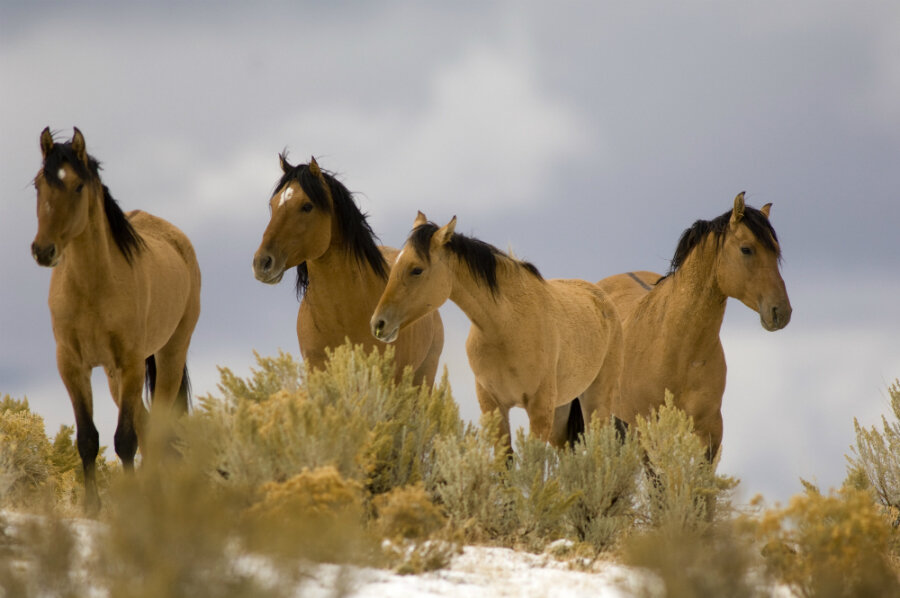Would the US government consider killing 44,000 wild horses?
Loading...
Rumors that the US Bureau of Land Management (BLM) voted to slaughter some 44,000 healthy wild horses living in off-range holding facilities have gained traction online this month, stoking outrage on social media among admirers of the animals. The rumors aren't entirely true.
The vote, as Snopes.com noted on Tuesday, was made by an advisory board that offers recommendations to the BLM, not the BLM itself, meaning it does not amount to a decision to carry out the euthanasia. Ginger Kathrens, a board member and advocate for the humane treatment of animals who was the sole dissenting vote against the recommendation, told the rumor research site that it was unclear what the next step in the process would be. And the BLM has not said whether it would accept the recommendation.
The vote resurfaces a decades-old conflict over the fate of wild horses that sometimes pits the concerns of animal-welfare advocates against federal officials and scientists who warn of the effects that precipitous growth in the horses' numbers can have on the health of ecosystems – and potentially on the horses themselves.
The ballooning populations of wild hoofed animals include burros as well.
As of March 1, 2016, the current estimated on-range wild horse and burro population is 67,027, a 15 percent increase over the 2015 estimate of 58,150, according to the BLM. The US land management agency says that horse and burro herds tend to double every four years.
In Arizona alone, BLM rangeland management specialist John Hall estimates that 600 to 700 burros roam in a million-acre region called Cibola-Trigo Herd Management area, according to the Associated Press.
"Nationwide, it's easier to adopt out burros than wild horses," said John MacDonald, manager of the BLM's Yuma field office told the AP. "No. 1, I think is they're cuter. Two, you can put them in your backyard where you can't do that with a horse. Around here people can use them for packing or hiking."
The management of the herds is complicated by the facts that wild horses – the feral descendants of domestic stock that either escaped or were turned loose on Western ranges – have long served as symbols of frontier freedom in the United States, a romantic perception that has irked ranchers for nearly as long, The Christian Science Monitor noted in 2005:
[R]anchers see [wild horses] as competitors for grazing cattle across millions of acres of arid range – "hoofed locusts," as John Muir once said about sheep. And like the cougars and bears that have been showing up in residential areas, they're also competing with humans for habitat.
… While the number of wild horses is far less than it was a century ago, many thousands having been killed for pet food and sport, the population, left unchecked, could grow rapidly. Except for occasional mountain lion attacks, horses in the wild have no predators. Herd populations grow about 20 percent a year, less in some years but as high as 40 percent with sufficient food supplies and the right weather.
At its current level, the wild horse population is 40,000 more than what the BML calls an "appropriate management level." The management agency is tasked with finding the best way to keep the population in check but is caught in the difficulties of navigating between the challenges of administering birth control to large, intelligent, and powerful animals and litigation from animal rights advocacy groups.
In 2014, The Monitor reported that President Obama had signed into law a bill that effectively banned the slaughter of horses for human consumption in the US by providing no funding for meat inspectors at packing plants.
There’s never been a big market for horsemeat in the US, but no such high-mindedness (or squeamishness) exists in some other countries. The next step, say animal rights groups, is to ban the export of live horses to other countries where horsemeat is consumed or prepared for shipment to Europe and Japan.
“We Americans care for horses, we ride horses, and we even put them to work. But we don’t eat horses in the United States,” Wayne Pacelle, president and CEO of The Humane Society of the United States, said in a statement following the House and Senate action this week. “And we shouldn’t be gathering them up and slaughtering them for people to eat in far-off places.”
In a press release last week, the Humane Society denounced the advisory board's recommendation and blamed the BLM for longstanding mismanagement of wild horse populations.
"By focusing massive efforts on removing horses and burros from the range, without treating those horses remaining on the range with any form of fertility control to limit population growth, holding facilities throughout the United States have become overburdened," it wrote.
The BLM has acknowledged the necessity to improve its population control methods, but sterilization plans have run into snags. In Colorado, the agency backed off of a plan in September in response to litigation from Front Range Equine Rescue, a nonprofit that advocates for wild horses, that it said would put staff at unnecessary risk while implementing the sterilizations, according to the Denver Post.
Material from the Associated Press was used in this report.








